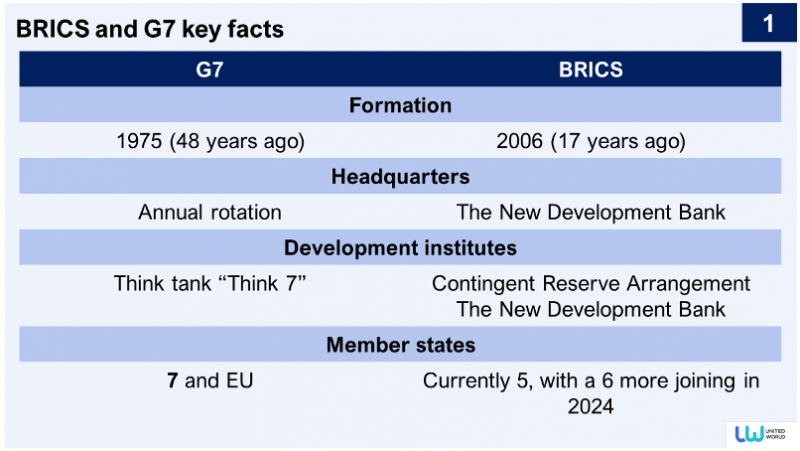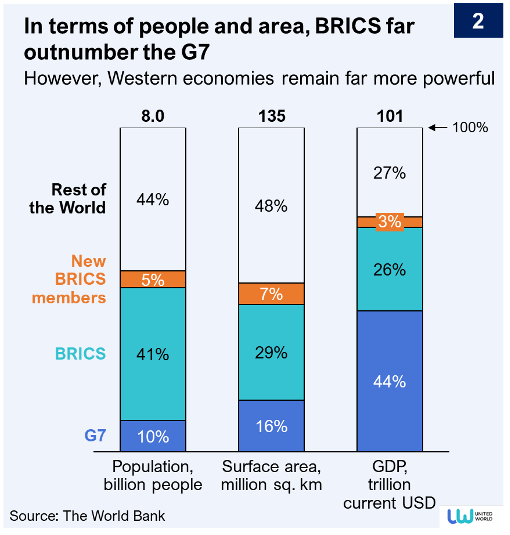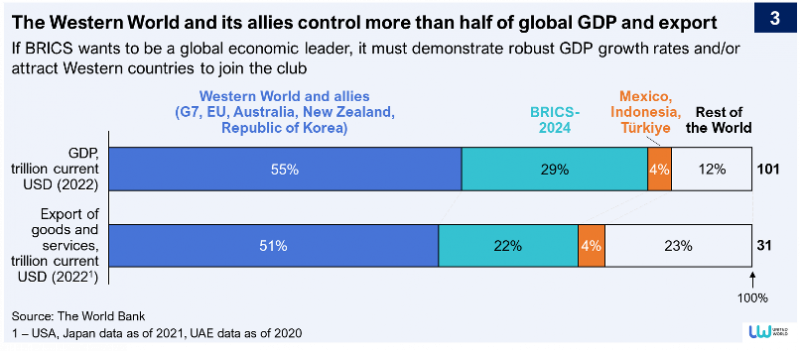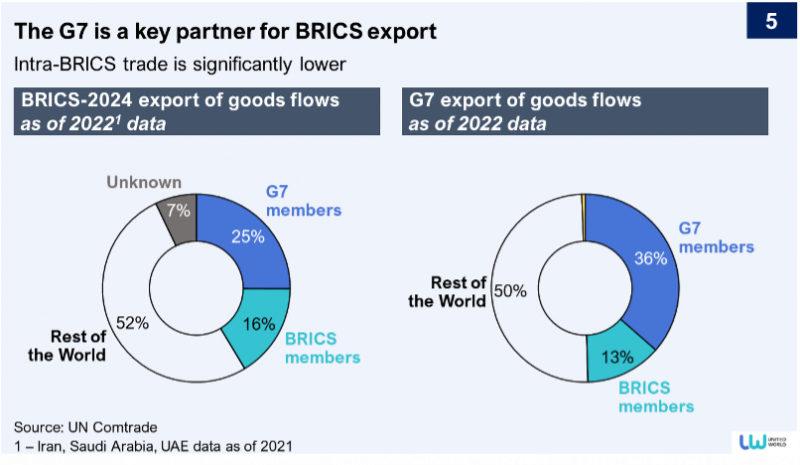By Dave Green
United World International publishes a number of publications that explore the present and future of BRICS, as well as compare the bloc with other international organizations.
Our goal is to study and forecast BRICS progress by looking at some notable and intriguing indicators. This ongoing project aims not only to observe BRICS’ development in the coming years, but also to make policy recommendations and forecasts. By analyzing transparent data, we construct economic solutions, not observe political decisions or politicians’ behavior within this dossier.
As many countries apply to become members of or consider joining BRICS, the bloc is becoming increasingly influential. Recently, BRICS welcomed six new members, while a dozen others await admission.
This publication examines a number of BRICS indicators to get a sense of the challenges BRICS is facing.
New BRICS member states: new order or big work ahead?
This year’s BRICS summit in Johannesburg, South Africa, has revealed the bloc’s ambition to lead the world 17 years after it was founded. Global economic and political agendas are buzzing about the consequences. In 2024, six new members will join the bloc. Argentina, Egypt, Ethiopia, Iran, Saudi Arabia, and the United Arab Emirates are the newcomers, and one could hardly imagine finding those in the same list or coalition before. Several countries are also considering joining. We brand the updated BRICS’ squad as “BRICS-2024” in this article.

This analytical article examines some high-level indicators to understand the impact of recent BRICS expansion on its global positioning.
Resource-rich BRICS needs to boost its economy first
Rapid economic development will be crucial in the years ahead for BRICS. Imagine being 17 years old and feeling all the advantages of youth but relying on your parents’ money instead of your own. That is where the BRICS bloc stands today. Invented by an American investment banker 20 years ago, the alliance currently operates across a huge 40 million square kilometers. It also unites 3.2 billion people. This is literally almost half of the world. The 48-year-old G7 bloc, the implied BRICS rival, is far behind in terms of this. But, as previously mentioned, money is in parents’ hands. G7 generates 44 percent of global GDP, while BRICS contributes 26 percent. In this way, BRICS economies produce only 60% of G7 GDP in nominal US dollars, despite having 4 times as many people and 1.8 times as much territory.

Some BRICS member states, such as China and Russia, challenge the Western World everywhere they can. However, when it comes to the economy, the BRICS alliance should focus on internal economic matters first. As new BRICS member states arrive, the alliance’s global economic position will not immediately change. It will continue to stay behind the Western World economically, while the latter also contains the European Union and some other countries in addition to G7. The BRICS will remain the runner-up despite substantial influxes of new people (approx. 420 million) and territories (approx. 9 million square kilometers). According to GDP and export indicators, the West will still control more than 50% of the global economy.
As the Western World and the “BRICS-2024” blocs both hold impressive 84 percent of global economy, there is no simple solution for BRICS towards global economic dominance like absorbing all other countries. The share of “Rest of the World” countries in global GDP (12%) and exports (24%) is too small to gain a majority in the world economy. Therefore, some sophisticated scenarios should be implemented if BRICS dominance is on the agenda. For instance, a few independent large countries that hold a significant share of GDP and exports, including Mexico, Indonesia, and Türkiye, might be invited to the bloc. For BRICS to achieve its ambitions of world leadership, incorporating these nations would be a major step forward. A strong alliance like the BRICS bloc should be attractive to large countries, and its advantages should be obvious to them. Thus, impressive growth rates should be demonstrated. As an ultimate step, it would be a global win in case any Western world countries joined the alliance. It would be a crucial step to gain a dominant position in the world economy for BRICS. But is it achievable, at least in the midterm?

The G7 remains too large to forego international trade with them
New member states are expected to boost BRICS’ global goods and services exports by 18% (approximately 1 trillion USD) by 2024. Politicians may claim this impressive dynamic as a way to separate from Western economies. But this is not exactly true, as G7 is a key partner of BRICS incumbent members and newcomers as well. Due to the high volume of trade, countries in the BRICS bloc are the most likely to have to deal with G7 nations in the near future. Nearly one-fourth of “BRICS-2024” exports will be delivered to the G7 nations, according to the trade data. Moreover, the UAE and Saudi Arabia conceal the final destination of oil and derivatives exported, so one-fourth is a minimal estimate of exports to the G7 countries as it is not rocket science to assume the majority is exported to the developed Western countries.


To get the potential BRICS bloc’s results, we summed up the results of the countries using historical data as a guide to future trade trends. A fair question: is there any room for synergies? Yes, there is, but challenging work is ahead of BRICS. If the BRICS bloc aims to attain real trade and economic independence from the West, it will need to concentrate on practical measures to boost intra-BRICS trade. The fact that BRICS countries have increased exports sharply since new members arrived is certainly good news. However, this raises some tough questions. Will the bloc of 11 countries really increase trade with each other at a level comparable to the G7? Is it necessary to create new comprehensive international agreements that foster intrabloc trade? Are all of these old and newly-minted BRICS member states equipped to produce and trade goods and services of high quality demanded by their bloc peers? Will these potential trade agreements conflict with the WTO ones? In any case, “BRICS-2024” has much work ahead, and cooperation is key to achieving its goals.
The Middle East as an emerging BRICS hub?
BRICS member states have always been too far apart, creating an impression that they are a “paper bloc” as well as being quite different countries. Yes, the BRICS bloc is covers 29% of Earth’s surface area but what about similarities and proximity to each other? The average flight distance between the five BRICS nations’ capitals has always exceeded 9,000 kilometers. In contrast, G7 capitals are only 5,000 kilometers apart. BRICS capitals will be closer to each other by 2,000 kilometers after the addition of new members in January 2024. Will that stimulate them to communicate on a daily basis?

BRICS expansion may make Middle Eastern nations the main winners in this part of geopolitical competition. Distance still matters to us all because we all live on this planet, and we are not eager to settle for Zoom parties every time. Answering the simple question what the closest place is to meet for “BRICS-2024” participants, we will find out that none of the founders’ capitals were the closest places to meet physically. At the same time, Middle Eastern Abu Dhabi and Riyadh have become the closest. In order to join the informal World Capitals club, Middle East countries will compete to take advantage of their geographical advantages. Cairo, Tehran, and Addis Ababa also may compete to hold the regular BRICS events and might try to increase their regional influence as well.

BRICS Perspectives – big work ahead
BRICS development perspectives may seem pessimistic in this article, but we do not think so. Our opinion is that there’s enormous work ahead of the bloc as a whole and each member state in particular. Western dominance has lasted several centuries, and it would seem unlikely to be possible to eliminate it simply by appointing new, even strong, “Rest of the World” member states. As BRICS expands, Western countries are also launching new projects (India-Middle East-Europe Economic Corridor) and the G20 continues to grow (the African Union was accepted as the 21st member at the New Delhi summit). In this world, do we see room for BRICS ambitions? Yes, we believe so, and the key is good strategic planning and institutionalization.
There is a lack of clarity regarding BRICS’ ambitions at this point, and that is the first thing to be resolved. If BRICS wishes to be a global leader, its member states need to state their goals and strategies. An unbeatable argument for this would be the prosperity of ordinary people in the bloc as a result of global leadership. Perhaps it would make more sense to set a goal of achieving Scandinavian living standards, for instance? When countries agree to implement this strategy, they may be able to find any other practical solution more quickly. Regional states such as Mexico, Indonesia, and Türkiye, which are quite independent but influential, can support this argument, as they struggle to develop sustainably despite strong neighbors in some cases. Therefore, these countries may complement BRICS’ transcontinental nature and add depth to its potential economic and international trade development.
The strategy must be granular to take real action, a well-known statement. This means concentrating the resources and capabilities of each BRICS member in international relations. There are many high-tech goods produced by China, India, Russia, and Brazil (although with the strong leadership of China), and there are plenty of natural resources available to them too. As well as being rich in fossils, other BRICS countries have strong agricultural capabilities. It is necessary for the BRICS countries to have a framework for their intra-BRICS cooperation. So that the creation of institutions and rules is a must.
But let us be honest, at the end of the day, it is all about the money! Profitability of intra-BRICS projects is another “must”. In today’s competitive environment between BRICS countries and Western countries, the question is crucial whether cooperation is profitable. If cooperation is not profitable for all parties involved, the bloc-competitor can offer alternatives. In the next articles, we will discuss how we see the BRICS’ potential cooperation and what kind of institutions might be launched first.
Conclusion
We found in this article that the expansion of BRICS will not change global economic dispositions immediately. Western economic dominance will remain, even if BRICS simply absorbs all countries except Western ones. It is only through a unified vision and strategy that BRICS can surpass the Western world economically. Alternatively, the alliance could be compared to a club of countries that wish to dominate the world but fail to act. It would certainly be difficult to find the solution that satisfies all the member states of “BRICS-2024”. But if there is a time to demonstrate the BRICS global ambitions on the scene, it is better to decide who should do what even by playing rock-paper-scissors rather than doing nothing. More seriously, the BRICS countries should hope they can come together and make some solutions – otherwise, they may have to start looking for creation of one more “global alliance” right now.
One more thing, even though it may sound quite technical. What is the future name of BRICS? Briefly, if the bloc sticks to its well-advertised BRICS name, would it not signal to the public that there are no global ambitions, and the bloc would like to stick the previous path? By choosing a more global name, this may indicate that the bloc intends to challenge the western rule-based order more decisively.
In the end, BRICS’ future will be determined by how it recognizes itself and its objectives, and how it plans to implement them. With Western-isolated Russia chairing BRICS in 2024, we should see its attempts to transform BRICS into something more influential very soon.

















Leave a Reply